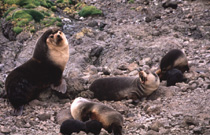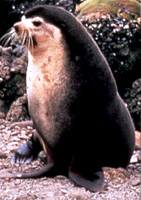Subantarctic Fur Seal
(Arctocephalus tropicalis)
IUCN STATUS (2010) - LEAST CONCERN
| Distribution and Numbers The breeding colonies of the Subantarctic fur seal, formerly known as the Amsterdam Island fur seal, are generally found on temperate islands in the South Atlantic and Indian Oceans, north of the Antarctic Polar Front. The largest colonies occur at Gough, Amsterdam and the Prince Edward Islands. Colonies have also recently been established at Tristan da Cunha, St Paul, The Crozet Islands and Macquarie Islands. Wandering individuals, mostly young males, have been sighted as far north as Brazil, Angola, the Juan Fernandez Islands and the Comoro Islands, while individuals are also occasionally seen in Australia, New Zealand and South Africa. At least 80,000 pups are born annually, giving a world-wide population of between 277,000 and 356,000. |
 Photo: Miguel I��guez, Fundacion Cethus |
| Status The species was hunted almost to extinction in the 19th century for its fur, and some island colonies were totally wiped out. Small-scale killing for fishing bait and skins took place at Gough Island until the 1950s. All of the colonies are now protected by legislation. Since being afforded protection, Subantarctic fur seals have started to colonise new locations and most populations now show growth rates of 13-15% or more. The Subantarctic fur seal is listed as an Appendix II species under CITES. There appear to be no major threats currently facing the species. |
| Subantarctic fur seals on World Heritage listed Macquarie Island were afforded additional protection in 2000 by the creation of a new federal 16 million hectare Marine Park on the eastern side of the island. The Tasmanian government also announced in 2000 an extension to the Macquarie Island Nature Reserve to cover all Tasmanian waters out to three nautical miles surrounding the island. |
| A recent genetic study was carried out to investigate the potential impacts of commercial sealing and range contractions on the genetic variation and population structure of Subantarctic fur seals. The study revealed that despite commercial sealing, high levels of genetic diversity and population structure are still present in the species. Three genetic lineages or clades are apparent, none of which represents fixed geographic distributions. However the seals from Gough, Prince Edward and Amsterdam Islands all differ significantly in the percentages of each clade represented in their populations. The recently established populations at The Crozet Islands and Macquarie Island are more similar genetically to each other than they are to any of the potential "source" populations. Results suggest that these populations were recolonised primarily by animals from the Prince Edward Islands and, to a lesser extent, Amsterdam Island. |
 Photo: Simon Goldsworthy, Latrobe University |
Lifestyle The Subantarctic fur seal usually hauls out on rocky shores from November to January in order to breed. The adult males arrive at the breeding grounds just prior to the females and form territories, usually containing between 4-12 females. They defend these territories by means of fighting, vocalisation and bluff. The females usually arrive in November-December and their pup is born a few days later with a black coat. Mating takes place about a week after the birth and the female then begins a cycle of feeding at sea for approximately 5 days (although foraging trips lasting a month have been reported) and returning to nurse her pup on land for 2-3 days. The milk that the mothers feed their pups is high-energy, containing approximately 39% fat. |
| Recent research has revealed that lactating females on Amsterdam Island have one of the longest attendance cycles of the fur seal species, spending an average of 11-23 days at sea from summer to winter. The time that mothers from Amsterdam Island spend ashore nursing their pup is also long, up to 4 days, but remains constant throughout the year. Lactating female Subantarctic fur seals have been recorded foraging up to 530km from their breeding islands, and appear to forage in association with oceanographic frontal zones where food availability is expected to be greater. Foraging dives are generally shallow and occur mostly at night when the seals' main prey, myctophid fish, migrate near to the surface. Subantarctic fur seals also consume squid. |
| The pup's black coat is moulted when it about 3 months of age, and pups continue growing up to about 220 days of age, after which they begin to lose weight until they wean at around 281 (� 30) days. The adult coat is typically characterised by a dark brown back and a creamy yellow chest. Adult males are usually darker than females and have a dark crest on the top of their head that stands erect when they are excited. Individuals of the species have a characteristic pale "facial mask" that distinguishes them from all other fur seals. Adults moult their coats between March and May. Subantarctic fur seal breeding colonies sometimes share space with Antarctic fur seals (Arctocephalus gazella) and there is evidence of some inter-breeding between these species at Marion and Macquarie Islands. Sharks and killer whales are known predators. Statistics Adult males usually measure up to 1.8m in length and weigh up to 165kg (average 131kg), while adult females are about 1.5m in length and weigh approximately 50-55kg. Pups are born about 65cm long and weighing 4-5kg. Females reach sexual maturity at 4-6 years of age, males at 4-8 years, although males do not achieve territorial status until 10-11 years of age. Males of the species are known to live over 18 years, females over 23 years. |
 Photo: Michael Bryden, University of Sydney |
